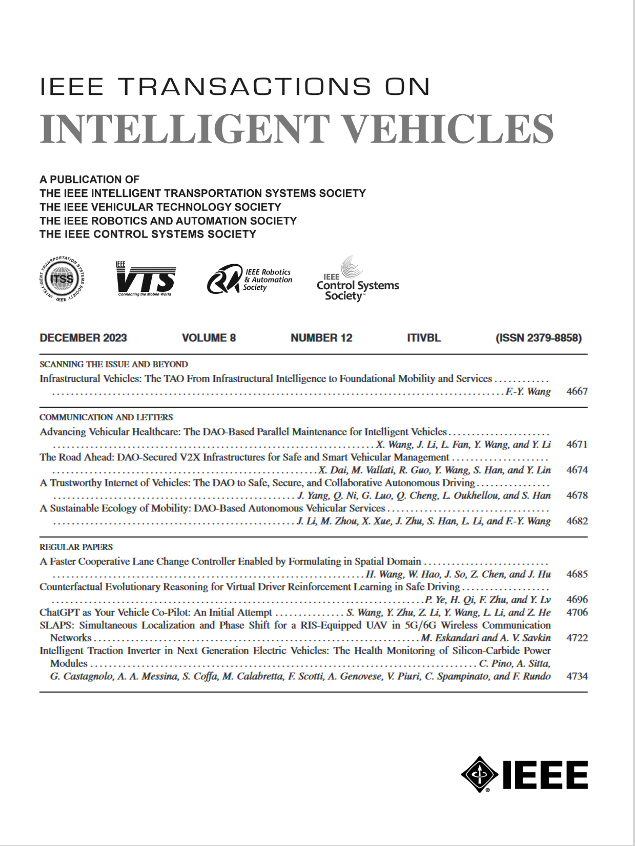An Online Energy Management System Based on Minimum-Time Speed Planning for Autonomous Underwater Vehicles
IF 14.3
1区 工程技术
Q1 COMPUTER SCIENCE, ARTIFICIAL INTELLIGENCE
引用次数: 0
Abstract
Velocity of autonomous underwater vehicles (AUVs) plays a significant role in the energy consumption of these vehicles, as well as their other capabilities, such as localization, maneuverability, and time to complete assigned missions. In this paper, for the first time, an online energy management strategy (EMS) is proposed for AUVs, which enables approaching the target in minimum time by adjusting the sub-optimal speed according to the amount of available energy. In this model-based energy management system, a framework is proposed that its output is the highest forward speed, so that the mission duration is minimized and the stored battery energy is used in the best possible way. In this field, existing efforts are mostly focused on reducing energy consumption, without considering other vehicle capabilities, but this method tries to reduce this gap. First, the architecture of an AUV propulsion is described and modeled, and a nonlinear equation is derived to generate the sub-optimal speed, which simultaneously minimize the amount of energy consumption and the time to reach the target. Then, for online implementation of this algorithm, a framework is proposed that generates the desired speed by using the battery state of charge (SOC), the voltage and the instantaneous Distance to destination. Illustrative simulation examples were conducted in MATLAB/Simulink to demonstrate the validity of the proposed scheme and the hardware in the loop test is conducted to evaluate the computational complexity of algorithm. Finally, experimental results showed the practical effectiveness of the proposed EMS.基于最小时间速度规划的自主水下航行器在线能量管理系统
自主水下航行器(auv)的速度对这些航行器的能耗以及其他能力(如定位、机动性和完成指定任务的时间)起着重要作用。本文首次提出了一种针对水下机器人的在线能量管理策略(EMS),该策略通过根据可用能量量调整次优速度,使水下机器人能够在最短时间内接近目标。在基于模型的能量管理系统中,提出了以最高前进速度作为输出的能量管理框架,使任务持续时间最短,电池储能得到最大利用。在这一领域,现有的努力主要集中在降低能耗上,而没有考虑车辆的其他性能,但这种方法试图缩小这一差距。首先,对水下航行器推进系统的结构进行了描述和建模,并推导出一个非线性方程来生成次优航速,同时使能量消耗和到达目标的时间最小化。然后,为了在线实现该算法,提出了一个利用电池荷电状态(SOC)、电压和到目的地的瞬时距离来生成所需速度的框架。在MATLAB/Simulink中进行了说明性仿真算例,验证了所提方案的有效性,并进行了硬件在环测试,评估了算法的计算复杂度。最后,通过实验验证了该方法的实用性。
本文章由计算机程序翻译,如有差异,请以英文原文为准。
求助全文
约1分钟内获得全文
求助全文
来源期刊

IEEE Transactions on Intelligent Vehicles
Mathematics-Control and Optimization
CiteScore
12.10
自引率
13.40%
发文量
177
期刊介绍:
The IEEE Transactions on Intelligent Vehicles (T-IV) is a premier platform for publishing peer-reviewed articles that present innovative research concepts, application results, significant theoretical findings, and application case studies in the field of intelligent vehicles. With a particular emphasis on automated vehicles within roadway environments, T-IV aims to raise awareness of pressing research and application challenges.
Our focus is on providing critical information to the intelligent vehicle community, serving as a dissemination vehicle for IEEE ITS Society members and others interested in learning about the state-of-the-art developments and progress in research and applications related to intelligent vehicles. Join us in advancing knowledge and innovation in this dynamic field.
 求助内容:
求助内容: 应助结果提醒方式:
应助结果提醒方式:


